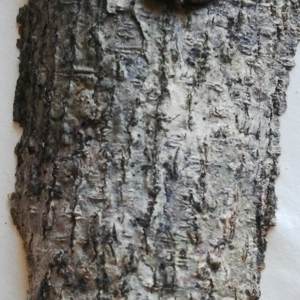Cola greenwayi
Cola greenwayi Brenan
Family: Malvaceae
Common names: hairy cola (Eng.); harige kola (Afr.); iNthandoti (Zulu)
SA Tree No: 478.1
Introduction
Cola greenwayi is a small to medium-sized evergreen tree, up to 25m tall with simple, alternate leaves that have a distinct hairy swelling below the blade and clusters of flowers along woody stems.

Description
Description
Cola greenwayi is a small to medium-sized perennial, evergreen tree of 3-25m high. Stem bark is grey-brown or dark brown, rough, flaking with young branches russet to light cinnamon brown or tomentose (densely covered with short, soft, felted hairs) at first, mixed with stellate or bunched hairs which fall readily.

Stipules are subulate-lanceolate to linear, 3-6mm long, dark to light brown or grey tomentose, and fall off early. Leaves simple, alternate, elliptic to oblanceolate, up to 270×75mm, glabrous at maturity, dark green above, paler green below, drooping, tapering at apex and base, margins entire, petiole up to 10-65mm long, with tomentose apical swelling below leaf base (pulvinus).

Inflorescences are one-flowered, axillary, solitary or fascicled and crowded on branchelets between the leaves. Flowers are unisexual, rarely bisexual, about 5×12mm, coloured by dark rusty brown, dense hairs, in leaf axial, in tight clusters along woody stems. Floral pedicels are jointed near the base, arising from sessile imbricating bracts which are 1.5-3.5mm long, without petals, sepals covered with rusty hairs, pedicels 7-20mm long, densely stellate-purbescent, hairs dark to light brown short or long, calyx 4-6-lobed almost to the base at flowering time, dorsally stellate-pubescent (with star-shaped hairs). Male flowers with staminal tubes about 2.5-4.5mm long, densely pubescent to subglabrous, anthers up to 8 in one row, sessile in a ring around the apex of stamina tube.

Female flowers with sessile ovary, densely stellate-pubescent, about 2 or 3mm wide, with a ring of rudimentary stamens around base, carpels 4-5 or less by abortion, orange yellow to deep orange. Flowering time is from October to January.

Fruit consist of 3-5 carpels, each about 20mm wide, joined in a ring, covered with dense short, soft, rusty-red hairs when young, yellow when ripe. Fruits ripen from November to May.

Conservation Status
Status
Cola greenwayi is Red Listed as Least Concern (LC).
Distribution and habitat
Distribution description
This species has a mainly tropical east-African distribution. In South Africa, it occurs in Mpumalanga and northern KwaZulu-Natal. It grows in evergreen forests and dense woodlands, ranging from sea level to steep mountain slopes to altitudes of about 1100metres.
Derivation of name and historical aspects
History
The name Cola is a West African vernacular name and greenwayi is after Percy J. Greenway (1897-1980), curator of the East African Herbarium and co-author of Kenya Trees and Shrubs. There are two species of Cola in South Africa: C. greenwayi and C. natalensis.
Cola greenwayi can be confused with C. natalensis but differs in that C. natalensis lacks brownish hairs on young branches, fruit is obovate and up to about 40mm long, and the rind is hard and thick.
Ecology
Ecology
Cola greenwayi grows in high-rainfall montane and sand forest regions.
Uses
Use
Species in the genus Cola are sometimes referred to as Kola tree or Kola nut and the caffeine-containing fruits produced by the trees are often used as a flavouring ingredient in beverages and a variety of soft drinks. The nuts are said to increase endurance of users. Cola greenwayi is used for fighting sticks and unspecified traditional medicine by the Zulu, wood for hut-building, firewood and the tree is an attractive garden plant.
Growing Cola greenwayi
Grow
Cola greenwayi is grown from seed or cuttings. Sowing time is all year round, and fresh seeds germinate reliably. Sow the seeds in soil at about 10mm depth. Seeds germinate better at temperature of about 25°C. Keep soil moist, but not too wet. Known pests are spider mites.
References
- Coates Palgrave, M. 2002. Keith Coates Palgrave Trees of southern Africa , edn 3. Struik, Cape Town.
- Raimondo, D., Von Staden, L., Foden, W., Victor, J.E., Helme, N.A., Turner, R.C., Kamundi, D.A. & Manyama, P.A. 2009. Red List of South African Plants. Strelitzia 25. South African National Biodiversity Institute, Pretoria.
- Schmidt, E., Lötter, M. & McCleland, W. 2002. Trees and shrubs of Mpumalanga and Kruger National Park . Jacana, Johannesburg.
- Smith, I.L.L. 1963. A gardener's dictionary of plant names . Cassell & Company Ltd, London.
- Sunshine seeds. Fruit and useful Plants. http://www.sunshine-seeds.de/product_info.php?products_id=52075&language=en
- Van Wyk, B. & Van Wyk, P. 1997. Field guide to trees of southern Africa . Struik, Cape Town.
- Verdoorn, I.C. 1981. The genus Cola in southern Africa. Bothalia 13,3 & 4: 277-279.
Credits
Nonkululo Phephu
Pretoria National Herbarium
January 2014
Plant Attributes:
Plant Type: Tree
SA Distribution: KwaZulu-Natal, Mpumalanga
Soil type: Sandy
Flowering season: Early Summer
PH: Neutral
Flower colour: Orange
Aspect: Full Sun
Gardening skill: Easy
Special Features:
Horticultural zones








Rate this article
Article well written and informative
Rate this plant
Is this an interesting plant?
Login to add your Comment
Back to topNot registered yet? Click here to register.